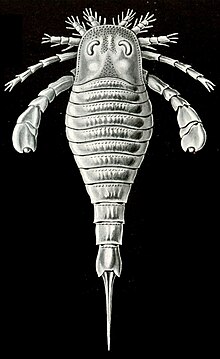Eurypterids
| Eurypterida Temporal range: Darriwilian-Late Permian, 470–252 Ma |
|
|---|---|
 |
|
| Eurypterid from Ernst Haeckel's Kunstformen der Natur (1904) | |
| Scientific classification | |
| Kingdom: | Animalia |
| Phylum: | Arthropoda |
| Subphylum: | Chelicerata |
| Class: | Merostomata |
| Order: |
† Eurypterida Burmeister, 1843 |
| Suborders | |
|
† Stylonurina Diener, 1924 |
|
† Stylonurina Diener, 1924
† Eurypterina Burmeister, 1843
Eurypterids (sea scorpions) are an extinct group of arthropods related to arachnids that include the largest known arthropods to have ever lived. They are members of the extinct order Eurypterida (Chelicerata); which is the most diverse Paleozoic chelicerate order in terms of species. The name Eurypterida comes from the Greek words eury- (meaning "broad" or "wide") and pteron (meaning "wing"). This name was chosen due to the pair of wide swimming appendages on the first fossil eurypterids discovered. The largest, such as Jaekelopterus, reached 2.5 metres (8 ft 2 in) in length, but most species were less than 20 centimetres (8 in). They were formidable predators that thrived in warm shallow water, in both seas and lakes, from the mid Ordovician to late Permian (470 to 248 million years ago).
Although informally called "sea scorpions", only the earliest ones were marine (later ones lived in brackish or freshwater), and they were not true scorpions. According to theory, the move from the sea to fresh water had probably occurred by the Pennsylvanian subperiod. Eurypterids are believed to have undergone ecdysis, making their significance in ecosystems difficult to assess, because it can be difficult to tell a fossil moult from a true fossil carcass. They became extinct during the Permian–Triassic extinction event or sometime before the event 252.17 million years ago. Their fossils have a near global distribution.
...
Wikipedia
